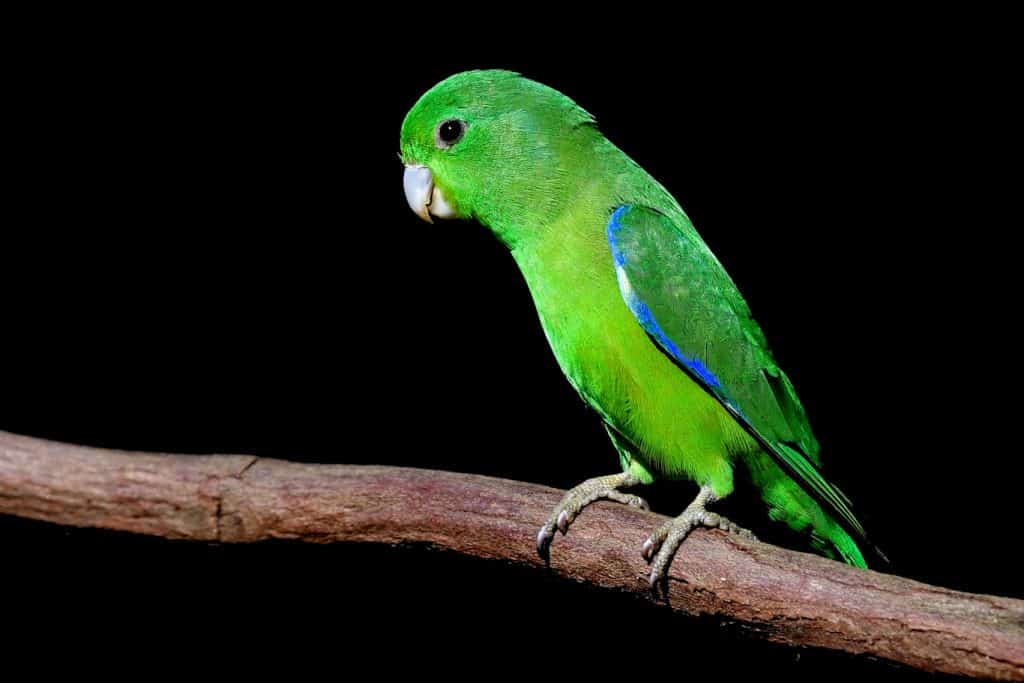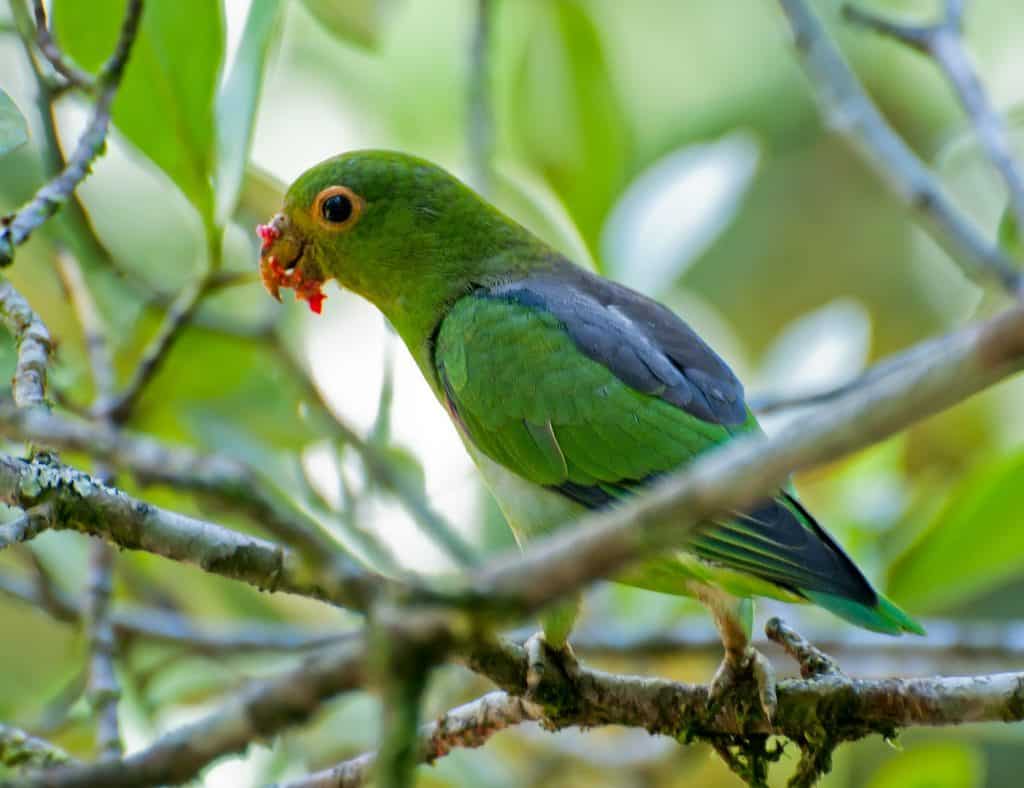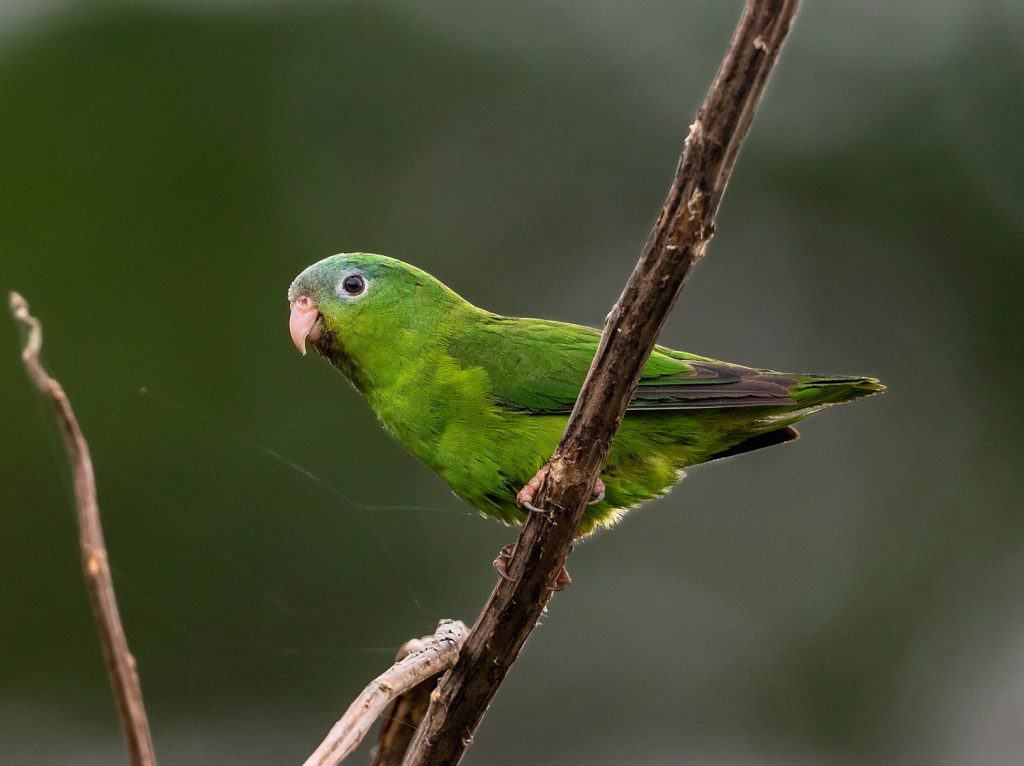As one of the smallest parrot species, parrotlets are cute and feisty companion parrots. But within the parrotlet species, there are different genera. So, here are the different types of parrotlets.
According to the Integrated Taxonomic Information System (ITIS), there are three types of parrotlet genera: Forpus, Touit, and Nannonpsittaca. There are 19 species of parrots labeled as parrotlets within these three genera.
The book, Parrots of the World by Joseph Forshaw lists these parrotlets in incredible detail and according to their ascribed genus. If you’re interested in learning more about parrotlets, then be sure to keep reading.
What Are The Types Of Parrotlets?
According to scientists, there are 19 species of parrotlets in total. These species fall into three genera. The three genera are Forpus, Touit, and Nannonpsittaca.
Many novice bird owners will confuse parrotlets and lovebirds because they are small-sized parrots.
According to the experts, the parrotlet and the lovebird are far from similar. Ornithologists consider parrotlets to be true parrots. They are closely related to the larger-sized Amazons.
Australian ornithologist Joseph M Foreshaw shares more of the different parrotlet species in his book, Parrots of the World.
He heavily emphasizes the Forpus and Touit genera because they are the most popular parrotlet genera in the pet trade world.
Here are the 19 species categorized according to their genera.
Genus: Forpus

- Mexican parrotlet (Forpus cyanopygius)
- Green-rumped parrotlet (Forpus passerinus)
- Cobalt-rumped parrotlet (Forpus xanthopterygius)
- Turquoise-winged parrotlet (Forpus spengeli)
- Riparian parrotlet (Forpus crassirostris)
- Spectacled parrotlet (Forpus conspicillatus)
- Dusky-billed parrotlet (Forpus modestus)
- Pacific parrotlet (Forpus coelestis)
- Yellow-faced parrotlet (Forpus xanthops)
Genus: Touit

By Dario Sanches from São Paulo, Brazil – APUIM-DE-COSTAS-PRETAS (Touit melanonotus )Uploaded by Snowmanradio, CC BY-SA 2.0, https://commons.wikimedia.org/w/index.php?curid=13254042
- Lilac-tailed parrotlet (Touit batavicus)
- Scarlet-shouldered parrotlet (Touit huetii)
- Red-fronted parrotlet (Touit costaricensis)
- Blue-fronted parrotlet aka red-winged parrotlet (Touit dilectissimus)
- Sapphire-rumped parrotlet (Touit purpuratus)
- Brown-backed parrotlet (Touit melanonota)
- Golden-tailed parrotlet (Touit surdus)
- Spot-winged parrotlet (Touit stictopterus)
Genus: Nannopsittaca

Manu parrotlet By Hector Bottai – Own work, CC BY-SA 4.0, https://commons.wikimedia.org/w/index.php?curid=107549568
- Tepui parrotlet (Nannopsittaca panychlora)
- Manu parrotlet, aka the Amazonian parrotlet (Nannopsittaca dachilleae)
The Forpus Genus
The Forpus genus consists of nine species. In the pet trade world, most experts refer to species of the Forpus genus as parrotlets. They are the most widely known parrotlet genus in the pet trade. Their native habitat is in Latin, Central, or South America.
There have been cases where parrot owners introduced members of this genus to nearby islands in the Caribbean. You can find these species in tropical areas, but they can survive in savanna and dry grassland environments.
According to authorities, the most widespread species in this genus is the Blue-winged Parrotlet, also known as the Cobalt-rumped parrotlet (Forpus xanthopterygius). One practical reason the genus is widespread is that it’s the only genus that owners can breed in the United States.
The Touit Genus
In 1855 English zoologist George Robert Gray introduced the Touit Genus with the Scarlet-shouldered parrotlet. You can find species of the Touit genus in Africa, South America, Europe, North America, etc.
The Touit genus isn’t as popular as the Forpus because only three species tried to integrate into aviculture. None of the integrations heralded a successful result.
The Nannopsittaca Genus
The Nannopsittaca genus is the last one on the list and contains only two species. Their natural habitat is in South American countries like Brazil and Venezuela.
Most of the parrotlet species’ natural habitat is in the Neotropical distribution. The Neotropical distribution refers to the tropical regions of the Americas and the entire South American temperate zone. The Neotropical region is just one of the eight geographic regions that make up the Earth’s surface.
The Most Popular Parrotlet Species
As shared earlier, members of the Forpus genus are the most popular. Still, they are also the most commonly kept parrotlet species. You may come across most of these species in the pet trade industry. The Pacific parrotlet and the Green-rumped parrotlet are the most available parrotlet species.
Here’s what makes these species the most popular in the parrot community.
The Pacific Parrotlet (Forpus Coelestis)
The Pacific parrotlet is undoubtedly the most popular parrotlet species. Not only are they small and cute, but they also make superb companion parrots. Because of their size, they are known as ‘pocket parrots.’
As shared earlier, most parrotlet species come from the Neotropical region. This fact applies to the Pacific parrotlet; they originate from South American countries like Venezuela, Brazil, and Mexico.
Thanks to a fierce and feisty personality, the Pacific parrotlet is a community favorite. It’s like a chihuahua in bird form, except it’s not as noisy. The best part is that they are adorable.
Pacific parrotlets are dimorphic, meaning that the males and females exhibit different characteristics. Male Pacific parrotlets are green with a blue rump and some blue streaks on their face.
On the other hand, you have female Pacific parrotlets that come in different shades of green. Due to breeding in aviculture, the Pacific parrotlet has come in different colors such as yellow, blue, and a darker shade of green.
Fortunately, the Pacific parrotlet isn’t a noisy companion parrot. They are also not the chattiest among Parrots.
Is The Pacific Parrotlet Good For Beginners?
The Pacific parrotlet can look cute, tiny, and incredibly appealing for beginners. They are ‘okay’ for beginners, but there are better options than parrotlet. Budgies are superb companion parrots for beginners; they are friendly, affectionate, and have great personalities.
Regardless, if you’re a beginner hell-bent on getting a Pacific parrotlet, it should be alright for the most part. Just make sure you do your research and are prepared.
The Blue-Winged Parrotlet (Forpus Xanthopterygius)
Another community favorite is the blue-winged parrotlet. It is also known as the Cobalt-rumped parrotlet. The Blue-winged parrotlet is primarily green; however, it is dimorphic.
The males have blue markings on their wings and rump while the female does not. Instead, the females have yellow-green foreheads. The native habitat of this species is in South America, similar to all parrotlets, and they tend to avoid densely forested areas.
If you’re interested in getting parrotlets, the blue-winged parrotlet is a suitable species. They are feisty but highly social. In the wild, you can find them in a group of over 50 individuals.
The Green-Rumped Parrotlet (Forpus Passerinus)
Next up on the list is the Green-rumped parrotlet. This species of parrotlet is the only one to occur in the Caribbean. The green-rumped parrotlet is also one of the most widely available parrotlets in the pet trade.
There are four subspecies of the green-rumped parrotlet:
- The Colombian Green-rumped parrotlet
- The Trinidad Green-rumped parrotlet
- The Roraima green-rumped parrotlet
- The Amazon Green-rumped parrotlet
They are also dimorphic, with the males having a purplish-blue color on the leading edges of their wings. In contrast, females do not have that blue hue but a yellowish-green color on their heads.
What makes the Green-rumped parrotlet popular? Out of all the parrotlet species, the green-rumped parrotlet is the least feisty or aggressive of the bunch.
Is The Green-rumped Parrotlet Beginner Friendly?
Like the Pacific parrot, it’s an ‘okay’ choice for a novice. The Budgie is still an excellent choice for beginners. The Green-rumped parrot is also an ‘okay’ choice, but there are other better beginner-friendly options for the species.
You can still get the Green-rumped parrotlet as a beginner despite all that. It would be in your best interest to research properly to get all the necessary tools to care for your parrotlet. It would also be best to consult with other bird owners that have experience with parrotlets either online or in-person.
The Case Of The Mexican Parrotlet (Forpus Cyanopygius)
The Mexican parrotlet is another community favorite; however, according to the IUCN Red List, the species falls in the Near Threatened category. The IUCN is a database that provides real-time information on the population state of animals.
The IUCN stands for the International Union for the Conservation of Nature. You can find pretty much any information on animal species on this database. HOWEVER, the IUCN Red List consists of animal species that are threatened, endangered, or extinct.
Parrots, in general, are the most sought-after pets in the pet trade industry. According to the IUCN Red List, the Mexican Parrotlet falls in the Near Threatened category. It means that the species is close to qualifying as critically endangered, endangered, or vulnerable.
The population of the Mexican parrotlet is suffering from a continuous decrease of mature individuals. Why? According to the IUCN Red List, hunting and trapping are the main threat to the species.
The Mexican parrotlet suffers from the illegal pet trade. In 2006, up to 8000 individuals of the species were in the illegal pet trade market. Hunting and trapping cause a rapid population decline in their natural neotropical habitat—Moreso in countries like Mexico.
What’s The Personality Of A Parrotlet?
As shared earlier, parrotlets are close to a chihuahua in bird form. Many small-sized parrot species have a similar personality. Or it could be the false misconception that the smaller the parrot, the smaller the bite.
Parrotlets have a beak, like any other parrot. Unlike some friendly parrot species, parrotlets are not afraid to inform you of that beak. They are feisty, willful, and affectionate.
At only 5-inches long, they are intelligent and have a lot of vigor. Bird owners get a massive gift inside a tiny package (parrotlet).
Another bonus to having parrotlets is that they’re not the chattiest of the bunch. Please note that they can repeat some words or phrases. Still, they’re not known for that ability, unlike some members of the Psittaciformes order.
You should note a massive disclaimer that parrots, in general, are individuals. Regardless of the general personality descriptions for a species, a specific parrotlet’s personality may be completely different.
Numerous factors go into what makes parrotlets different from one another. If you’re interested in getting parrotlets, interacting with the parrotlet would be in your best interest. It would help if you ascertained whether you and the parrotlet have chemistry. As wild as it may sound, clashing personalities between parrots and their caretakers is a huge problem.
What’s The Lifespan Of A Pacific Parrotlet?
As one of the most popular members among Parrotlets, you will likely come across a Pacific parrotlet at your local pet store. If you want to purchase one, it would be in your best interest to research the care and maintenance of your companion parrot.
According to the Animal Humane Society, the Pacific parrotlet has a lifespan of between 15 to 20 years. In some cases, they can extend that lifespan given the proper care.
The lifespan of your parrotlet correlates to its care, health, and maintenance. If your parrotlet is healthy and happy, it will live longer; if not, it will result in a shorter lifespan.
How To Care For A Parrotlet
Here are a few tips and tricks to help you properly care for your parrotlet to ensure a longer lifespan.
- Parrotlets are single-house companion parrots. They tend to be very territorial and do not share well. However, there are cases where parrotlets form a true pair, which means they like each. In most cases, the true pair is a male and female. Disclaimer: there are situations where having male and female parrotlet together can turn deadly.
- It would be in your best interest to choose an avian veterinarian.
- You should identify common health disorders. The primary health disorders for parrots, in general, are diet-based. Parrots need a balanced diet for a longer lifespan, so vets recommend feeding them pellets and not a seed-based diet.
- The bigger the enclosure, the better for the birds. Despite their small size, parrotlets require a lot of space. It would be best if they had a bigger enclosure. The bigger, the better, and parrotlets are like any other parrot. Except they are a lot smaller in size.
There are some theories that birds of the same size can co-exist in an enclosure. It works sometimes, but other times it doesn’t. It would be best to keep them in separate enclosures.
What’s The End Goal?
Parrotlets are small yet willful companion parrots. There are 19 species of parrotlets, and only a handful make it onto the pet trade. Ensure that you care for and maintain your parrotlet for a longer lifespan.
-
What Size Cage Is Needed For A Conure Parrot?
What size cage is needed for a conure parrot? Conures can be highly active and playful, so they need a dedicated space for flying and exploring. There should also be room for toys as they help keep conures occupied. A conure’s enclosure should be at least 18 to 24 square inches, depending on its size.…
-
Can Parakeets Eat Blueberries?
There’s no denying that parakeets are curious about everything. They are quickly intrigued and fascinated with anything new, especially regarding things they can consume or not. It’s in their nature to be curious about their surroundings. Besides, their wonder and curiosity took them into our hearts in the first place. Indeed, sometimes you get a…
-
The Costs Of Owning A Sun Conure Parrot
Sun conures (Aratinga solstitialis) are parrot birds known for their beauty and intelligence. Jandaya parakeets (Aratinga jandaya) and Golden-capped parakeets (Aratinga auricapillus) are taxonomically included in the group. They are bright-orange plumage on the forehead and abdomen. (source) These birds originated in northern and central-eastern South America. Naturally, they inhabited dry areas, settled in either…
-
A Complete Guide To Parakeet Sexing
You have finally adopted a parakeet and love spending time with your new pet as it’s making everyone in your home happy. But since it’s still a new pet, you’re still trying to figure out a perfect name for your bird. Unfortunately, you don’t know its gender since you got it as a gift or…
-
A Guide To Clicker Training For Birds
Finally, you can introduce clicker training for birds by asking them to continue doing what they love! It can be something as simple as a step up, a handshake, or a high-five. With your reward nearby and a clicker in your hand, you can verbally command your birds. And when your bird does it correctly,…
-
Macaw Blue and Gold Price (Plus 7 Things To Know)
Known for its stunning form and beautiful colors, the Blue and Gold Macaw truly is a glorious bird to look at, and it is no question to know that this bird also comes with a hefty price. Aside from its striking colors, it also is brilliant and, most significantly, high in demand. With such a…
- Nikki Moustaki, Parrots For Dummies, (New Jersey: John Wiley & Sons, Inc, 2005) 392.
- Joseph M. Foreshaw, Parrots Of The World, (New Jersey: Princeton University Press, 2010) 584.




